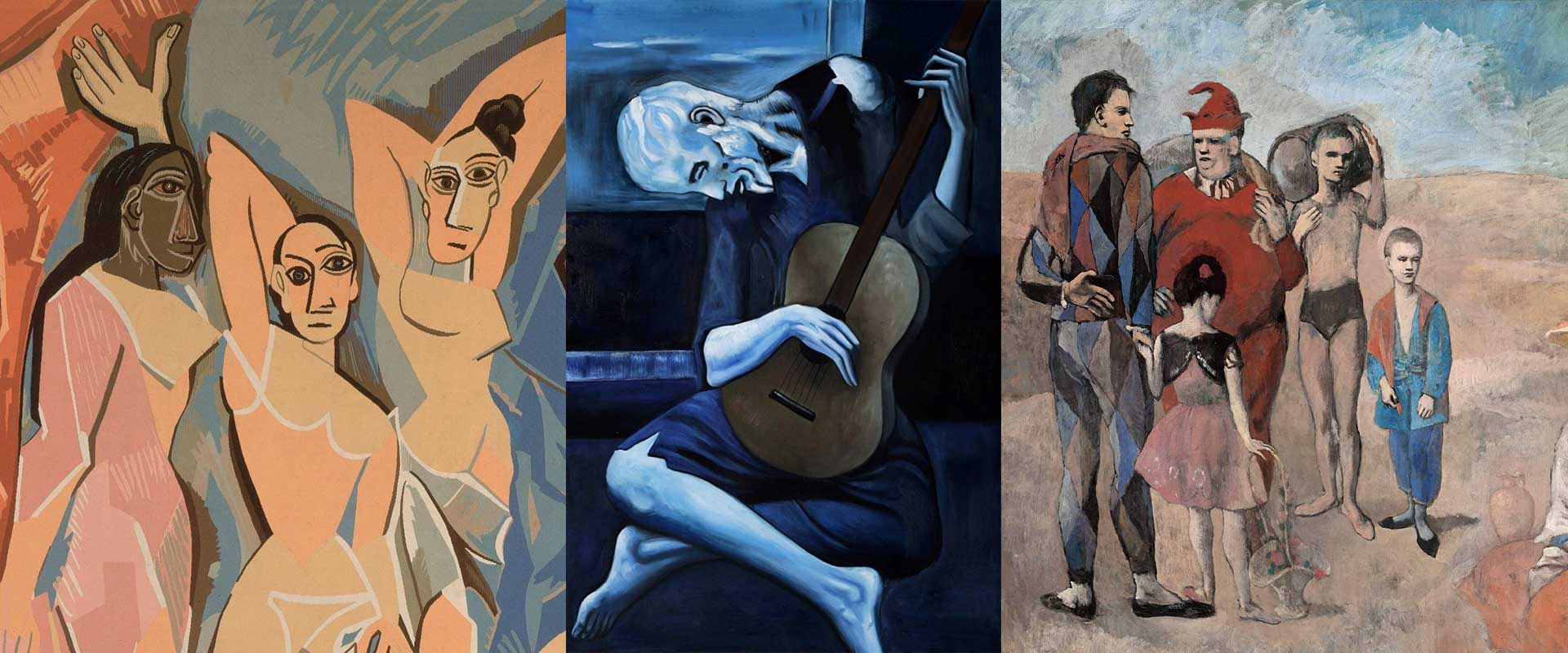Pablo Picasso was not just an artist; he was a force who reshaped the very definition of creativity. Over the course of his life, his art morphed into a mirror reflecting history, innovation, and emotion. Tracing Picassos through the decades reveals more than changing styles—it unveils a journey of experimentation, rebellion, and mastery.
From his somber Blue Period to the bold experimentation of Cubism, and eventually the vibrant late works that defied age, Picasso’s art tells a story not just of one man but of an entire century of change.
Early Years – The Blue and Rose Periods
Picasso’s first recognizable artistic chapters began with periods defined by mood and tone.
- Blue Period (1901–1904): After the suicide of a close friend, Picasso turned to shades of melancholy blues and grays. Works like The Old Guitarist embody human suffering and isolation.
- Rose Period (1904–1906): Transitioning into warmer colors, his art depicted circus performers and more whimsical characters. This marked the beginning of his fascination with the human condition in varied emotional states.
These early styles highlight Picasso’s emotional sensitivity, and they laid the foundation for the explosive innovation that followed.
The Breakthrough – Cubism
In the late 1900s, Picasso, alongside Georges Braque, pioneered Cubism, a radical departure from traditional art.
Cubism broke objects into geometric fragments, offering multiple perspectives simultaneously. One of the most defining works of this era was Les Demoiselles d’Avignon (1907), often described as the painting that changed art forever.
As discussed in Picasso Cubism: The Art Movement That Changed Everything, Cubism became one of Picasso’s lasting contributions to modern art, influencing architecture, sculpture, and even literature.
Between Wars – Classicism and Surrealism
The 1920s marked a return to more classical forms for Picasso. He painted neoclassical figures, embracing robust, monumental bodies that drew from Greek and Roman influences.
Yet, as the decade progressed, Surrealism began to shape his imagination. Works like The Dream show how Picasso absorbed and reinterpreted the subconscious themes central to the Surrealist movement.
The Turbulent 1930s – Guernica and Beyond
The 1930s were turbulent both politically and personally for Picasso. His masterpiece Guernica (1937) remains one of the most significant anti-war paintings ever created. Its symbolism and fragmented forms capture the horror of the Spanish Civil War.
Analyses like Guernica by Pablo Picasso: The Meaning Behind the Masterpiece show how the work transcended its immediate political context to become a universal cry against violence.
Bullet Points: Key Shifts in Picasso’s Art in the 1930s
- Increasingly politicized themes in response to war.
- Intense emotional imagery, often linked to personal relationships.
- Experimentation with both traditional portraiture and abstraction.
- Use of black, white, and gray palettes in his most dramatic works.
This period reveals how external conflict and internal turmoil fueled Picasso’s creative energy.
Mid-Century Works – The War Years and Beyond
During World War II, Picasso stayed in Paris under Nazi occupation, producing art that often carried subtle messages of defiance. His famous Weeping Woman echoes the sorrow of wartime trauma, while other works used coded symbolism to resist oppression.
After the war, Picasso experimented with ceramics, sculpture, and printmaking, expanding beyond painting. This multi-medium exploration demonstrated his refusal to be confined by any one discipline.
Later Years – Color, Freedom, and Reflection
Picasso’s later decades are often overlooked, yet they reveal an artist in constant dialogue with his past. Bold colors, simplified forms, and reinterpretations of Old Masters filled his canvases.
He revisited themes from Diego Velázquez and Eugène Delacroix, reimagining classical paintings in his own modern style. These reinterpretations blurred the line between homage and reinvention.
Collections such as Pablo Picasso Wall Art Prints showcase this late style, characterized by freedom and confidence rather than hesitation.
Comparison: Picasso’s Art by Decade
| Decade | Defining Style | Iconic Work | Characteristics |
|---|---|---|---|
| 1900s | Blue & Rose Periods | The Old Guitarist | Emotional depth, tonal exploration |
| 1910s | Cubism | Les Demoiselles d’Avignon | Geometric abstraction, multiple perspectives |
| 1920s | Classicism & Surrealism | The Dream | Monumental figures, subconscious imagery |
| 1930s | Political & Symbolic | Guernica | Anti-war symbolism, fragmentation |
| 1940s | War Years | The Weeping Woman | Emotional turmoil, resistance themes |
| 1950s–70s | Late Style | Las Meninas Series | Vibrant colors, reinterpretations of masters |
This timeline illustrates how Picasso’s art constantly evolved while always staying distinctly his own.
Bullet Points: Lessons from Picasso’s Evolution
- Adaptability: Picasso never confined himself to one movement.
- Innovation: From Cubism to ceramics, he explored every medium.
- Cultural Reflection: His art mirrored the world’s upheavals and joys.
- Fearlessness: Reinvention was not a phase—it was a lifelong habit.
These traits explain why Picasso remains at the center of modern art discussions today.
Conclusion
Studying Picassos through the decades is like reading a diary of the 20th century written in color, form, and emotion. Each decade brought reinvention, yet the unifying thread was Picasso’s insatiable drive to explore and challenge conventions.
By understanding his evolution—from somber beginnings to revolutionary Cubism and late-life brilliance—we see how Picasso became the ultimate shape-shifter of modern art. His legacy reminds us that art is not about remaining the same but about constantly becoming something new.
FAQs on Picassos Through the Decades
What was Picasso’s first major style?
His first widely recognized style was the Blue Period (1901–1904), characterized by somber blue tones and melancholic themes.
Which decade is most associated with Cubism?
The 1910s are most associated with Cubism, a movement Picasso co-founded with Georges Braque.
How did politics affect Picasso’s art?
The Spanish Civil War and World War II deeply impacted his work, leading to politically charged masterpieces like Guernica.
Did Picasso only paint?
No, he explored sculpture, ceramics, printmaking, and even stage design throughout his career.
What characterizes Picasso’s late works?
His late works are colorful, bold, and often reinterpretations of Old Masters, reflecting freedom and self-confidence.





